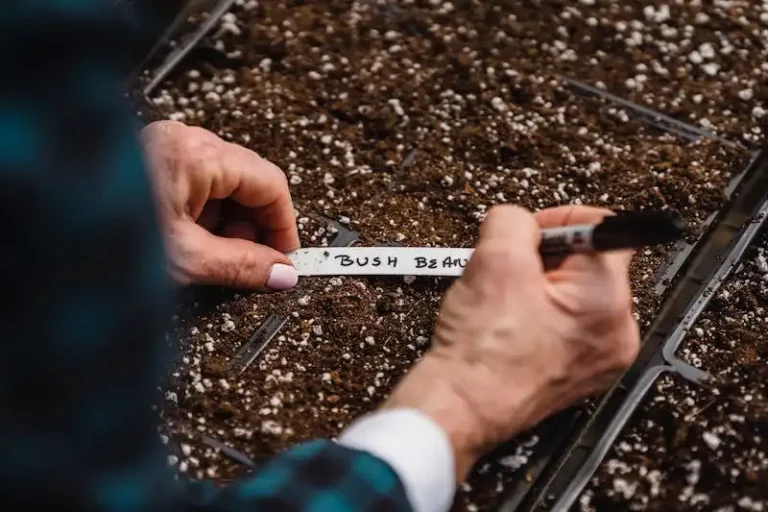Peace lilies are a popular choice for indoor plants due to their ease of care and beautiful white flowers. However, if you have a peace lily that is starting to outgrow its pot or if you simply want to make more plants out of your existing one, you can easily propagate it through plant division. This process involves separating the peace lily into smaller plants, each with its own roots.
The first thing you need to do is to prepare your peace lily for propagation. Start by watering the plant a day or two before you plan to divide it. This will ensure that the soil is damp and the roots are hydrated. Then, carefully lift the peace lily out of its pot, being careful not to damage its roots. If the plant is root-bound, meaning the roots are circling around the sides of the pot, gently tease them apart with your fingers to encourage new growth.
Next, you will need to divide the peace lily into separate segments. Look for natural divisions or offshoots, which are new plants that have grown on the sides of the main plant. These offshoots will have their own roots and can be separated from the main plant. Using a sharp and clean knife or garden shears, cut through the roots and separate the offshoots from the main plant. Each segment should have several leaves and its own set of roots.
After you have separated the segments, it’s time to plant them in their new pots. Choose pots that are at least 4-6 inches in diameter and have drainage holes at the bottom. Fill the pots with a well-draining potting mix, such as a mixture of peat and perlite. Make a small hole in the soil with your finger and gently place the segment in it. Firm the soil around the roots to ensure good contact.
Once the segments are potted, water them thoroughly and place them in a location with bright, indirect light. Keep the soil consistently moist, but not soaking wet, and avoid overwatering, as this can lead to root rot. Within a few weeks, you should start to see new growth on the segments, indicating that they have successfully taken root.
There are many benefits to propagating peace lilies through plant division. Not only does it allow you to make more plants out of a single one, but it also helps to keep the original plant healthy. By dividing the plant, you are giving it more room to grow and preventing it from becoming root-bound. Additionally, propagating peace lilies can be a great way to share the joy of these beautiful plants with others, as they make excellent gifts.
How To Split A Peace Lily – Step By Step
If you have a healthy peace lily and it has outgrown its current pot, it is time to consider splitting the plant. Splitting a peace lily is a great way to propagate and make new plants. Here are the steps to follow:
- First, prepare a new pot with fresh potting medium. Make sure the pot has drainage holes to prevent waterlogged roots.
- Take the peace lily out of its current pot and gently shake off any loose soil. Inspect the roots for any signs of disease or root rot. Remove any diseased or brown roots.
- Using a clean and sharp knife or shears, carefully separate the peace lily into two or more divisions. Each division should have its own healthy roots and foliage.
- To avoid spreading diseases, I recommend washing the knife or shears with alcohol before and after use and sterilizing them thoroughly.
- Put each divided peace lily into its own pot and fill it with the fresh potting medium. Press the soil gently around the roots to ensure good contact.
- Water the newly potted peace lilies thoroughly. Allow the excess water to drain out of the pots.
- Place the pots in a spot with bright, indirect light. Peace lilies prefer temperatures between 65-80°F (18-27°C) with high humidity.
- Keep the soil evenly moist but not soggy. Regularly mist the foliage to increase humidity.
- You can fertilize the new plants with a diluted houseplant fertilizer. Follow the package instructions for application rates.
- Monitor the plants for signs of distress or wilting. If necessary, adjust their care accordingly.
This step-by-step guide will help you successfully split a peace lily and provide new plants for yourself or to give as gifts. Remember to frequently repot the peace lilies every 1-2 years to promote their health and avoid overcrowding. Happy splitting!
When Should You Split A Peace Lily
If your peace lily is flowering and they’re healthy, it’s a good time to consider splitting them. Splitting a peace lily is essentially dividing the plant into two or more segments, each with its own root system. You can use a knife or your hands to separate the segments from the mother plant, making sure to have at least 4 to 8 leaves on each segment.
The benefits of splitting a peace lily are that it can help quickly rejuvenate the plant and promote more flowering. Peace lilies can sometimes outgrow their current pots, becoming root bound, and splitting them gives them more room to grow.
Before splitting a peace lily, you should prepare by repotting the mother plant into a larger container with fresh potting medium. Some peace lilies can be divided without repotting, but repotting ensures that each segment has enough roots to survive on its own.
To split a peace lily, take the plant out of its pot and gently pull the segments apart. In some cases, you may need to use a knife to separate them. Be careful not to damage the roots. Once you have separate segments, you can then pot them in their own containers, using a well-draining soil mix.
After splitting, it’s important to water the newly potted peace lilies thoroughly to settle the soil and provide moisture to the roots. Place them in a bright, indirect light location and keep the soil consistently damp, but not soggy.
It’s best to split a peace lily during the growing season, typically in the spring or summer. This gives the plant time to recover from the shock of division and establish new roots.
To promote healthy growth, you can fertilize your peace lilies with a balanced houseplant fertilizer. Follow the instructions on the fertilizer package for the correct dilution and frequency of application.
In summary, splitting a peace lily is a relatively easy and beneficial propagation method. By dividing the plant, you can rejuvenate it, provide more room for growth, and encourage more flowering. Splitting should be done when the plant is flowering, healthy, and showing signs of outgrowing its pot. Follow the steps mentioned above to ensure a successful division.
How Do You Split A Peace Lily
Splitting a peace lily is a great way to propagate new plants from an existing one. Whether your peace lily is getting crowded in its pot or you simply want to share the beauty of this plant with others, dividing it is quite easy to do. In this article, we will learn about the step-by-step process of splitting a peace lily and answer some common questions about peace lily division.
When to Split a Peace Lily
Most peace lilies can be divided every 2-3 years. If you notice that your plant is not blooming as much as it used to or its leaves are smaller than before, these might be telltale signs that it’s time to divide your peace lily. Additionally, if the roots are starting to grow out of the drainage holes of the pot, the plant is getting crowded and should be divided.
How to Split a Peace Lily
Here is a step-by-step guide on how to split a peace lily:
- Prepare the right medium: Get a potting medium ready by mixing equal parts of peat moss, perlite, and compost. This will provide a well-draining and nutrient-rich environment for the new sections of the peace lily to grow.
- Take out the peace lily: Gently remove the peace lily from its current pot. If the plant is tightly rooted, you may need to loosen the roots by rubbing them between your fingers.
- Inspect the roots: Check the roots for any signs of root rot or diseases. Trim away any damaged or dead roots with a clean and sharp knife.
- Divide the peace lily: Look for natural divisions within the plant, such as separate crowns or clumps of leaves. Use a clean and sharp knife to carefully separate these sections. Each section should have at least 3-4 leaves and a healthy root system.
- Pot the divided sections: Plant each section in a separate pot filled with the prepared potting medium. Make sure the crown of the plant is level with the soil surface.
- Water thoroughly: After potting, water the divided sections thoroughly until water drains from the bottom of the pot. This will help to settle the soil and remove any air pockets.
- Keep in indirect light: Place the newly divided peace lilies in a location with indirect light. Avoid direct sunlight, as it can cause leaf burn.
- Maintain proper care: Throughout the next few months, keep the divided sections consistently moist. Water whenever the top inch of the soil feels slightly dry.
By following these steps, you can successfully split your peace lily and have new plants to enjoy or share with others. Just remember to be patient, as it may take a few months for the newly propagated sections to begin growing and flowering.
What Are The Benefits Of Splitting A Peace Lily
Splitting a peace lily, also known as peace lily plant division, has several benefits. This method of propagation allows you to create new plants from a mature peace lily, promoting healthier growth and rejuvenation.
Here are some of the benefits of splitting a peace lily:
| 1. Faster growth: | By splitting the peace lily, you can create multiple plants that will grow faster than if you wait for the original plant to produce offshoots on its own. |
| 2. Healthier plants: | Peace lilies can become crowded in their pots over time, which can result in stunted growth and unhealthy roots. Splitting allows the roots to spread out, promoting healthier plants. |
| 3. Rejuvenation: | Splitting a peace lily gives the original plant a fresh start. This can help revive an older or struggling plant and improve its overall health. |
| 4. More plants: | One peace lily can be divided into multiple plants, giving you the opportunity to enjoy the beauty of these plants in multiple locations. |
| 5. Aesthetic appeal: | Peace lilies have beautiful foliage and flowers. By splitting them, you can enhance the appearance of your indoor or outdoor space with more of these stunning plants. |
When splitting a peace lily, it’s important to follow the right steps to minimize any shock or damage to the plant:
- Prepare a new pot with a well-draining soil mix, such as a combination of peat and perlite.
- Remove the peace lily from its current pot and gently separate the roots into sections.
- Use clean shears to cut the sections, making sure each segment has at least 3-4 leaves and a healthy root system.
- Plant each segment in its own pot, making sure the roots are covered with soil and the plant is stable.
- Water the newly potted plants until the soil is damp but not waterlogged.
- Place the pots in a location with bright, indirect light.
- Water the new plants regularly, keeping the soil moist but not overly saturated.
- Check the plants for any signs of stress or dehydration, and adjust watering accordingly.
Splitting a peace lily can be an easy and rewarding task that allows you to multiply the beauty of these plants. Just make sure to avoid the downsides – overwatering and too much direct sunlight – and your newly divided peace lilies will thrive for years to come!




